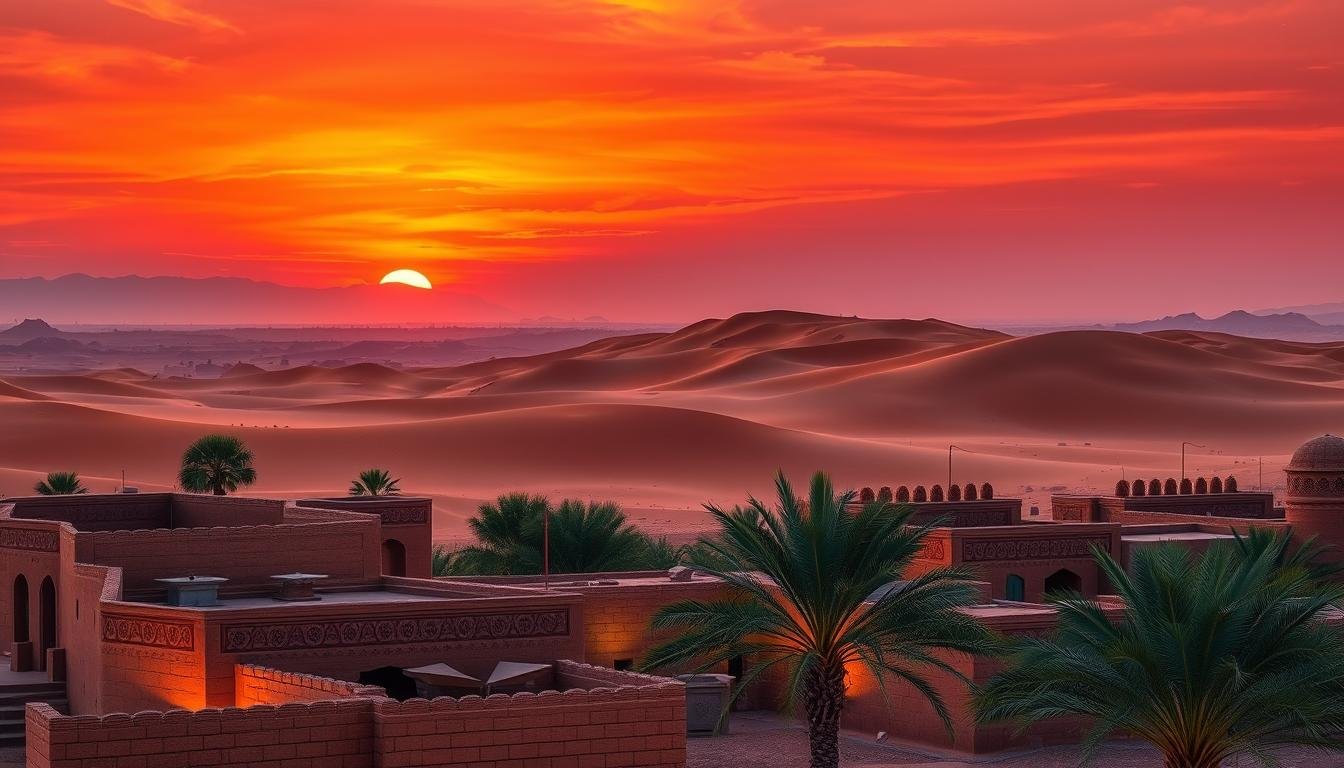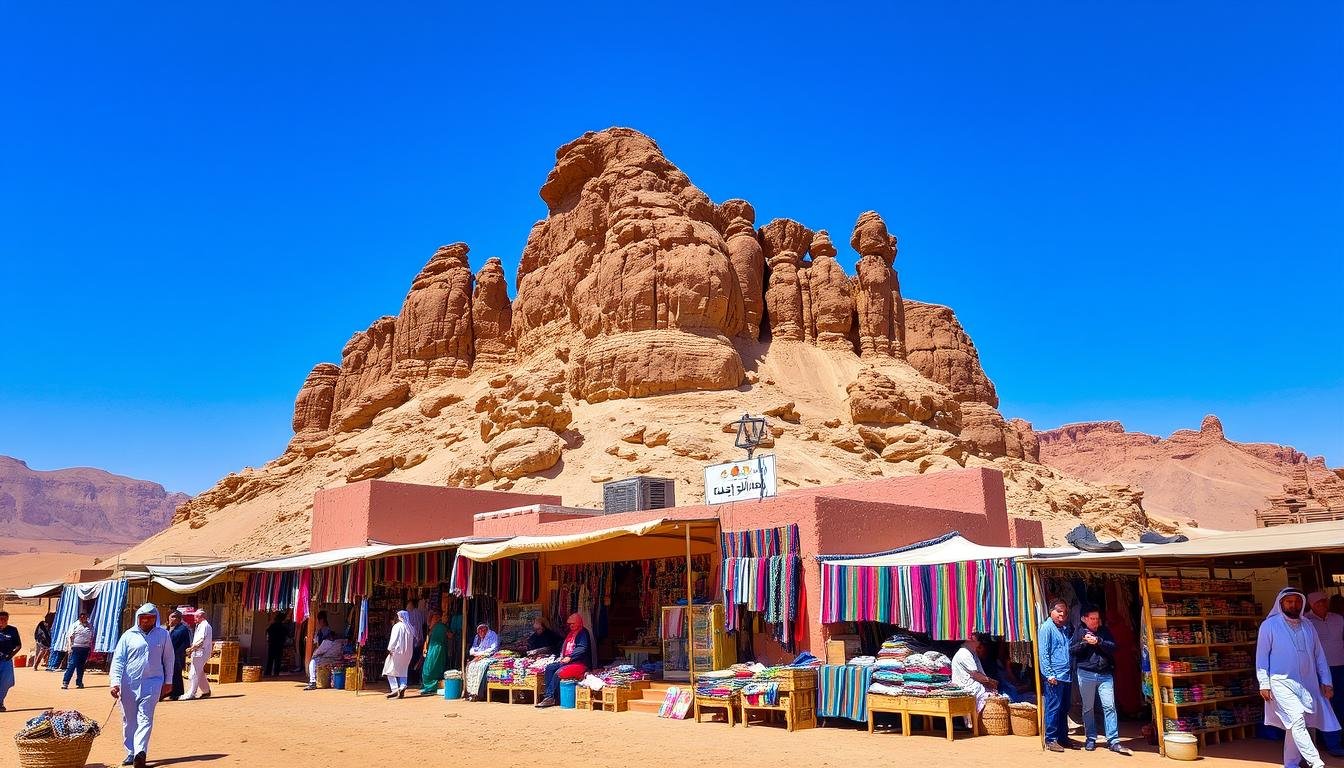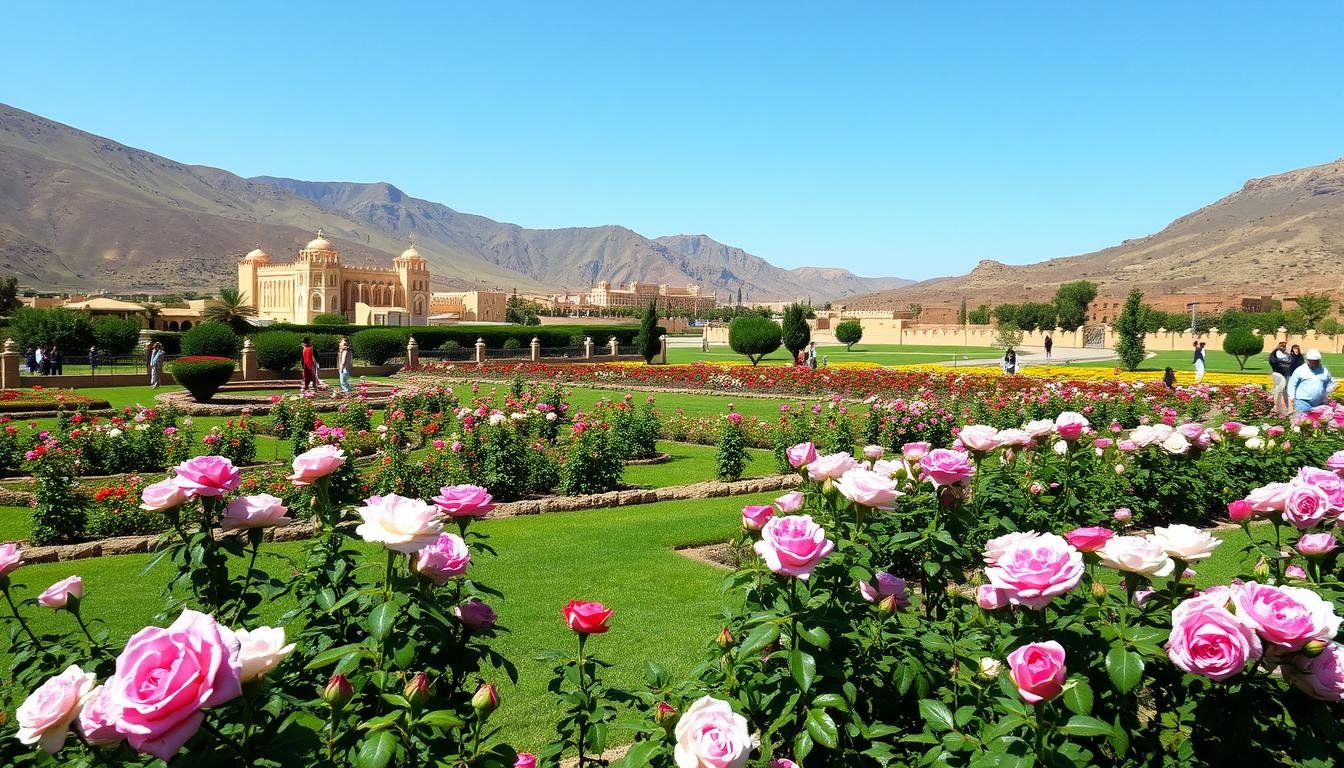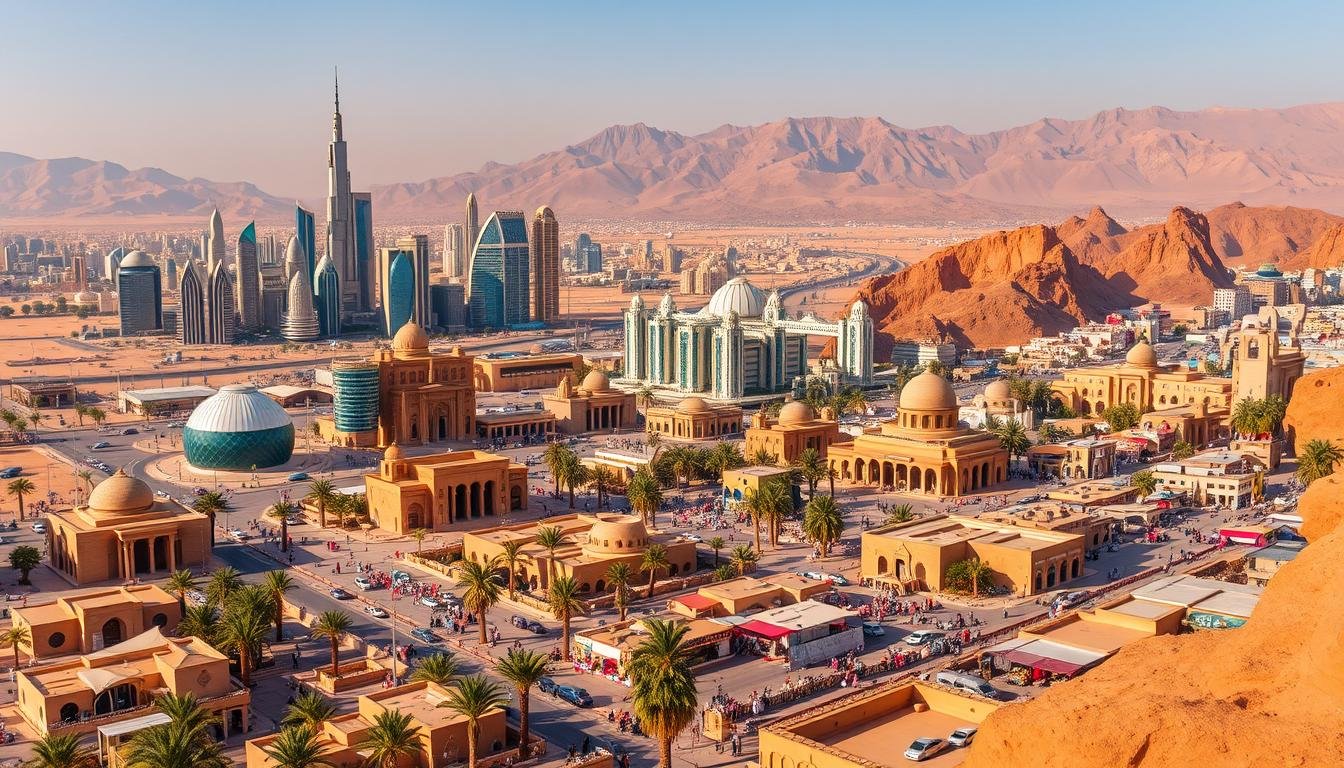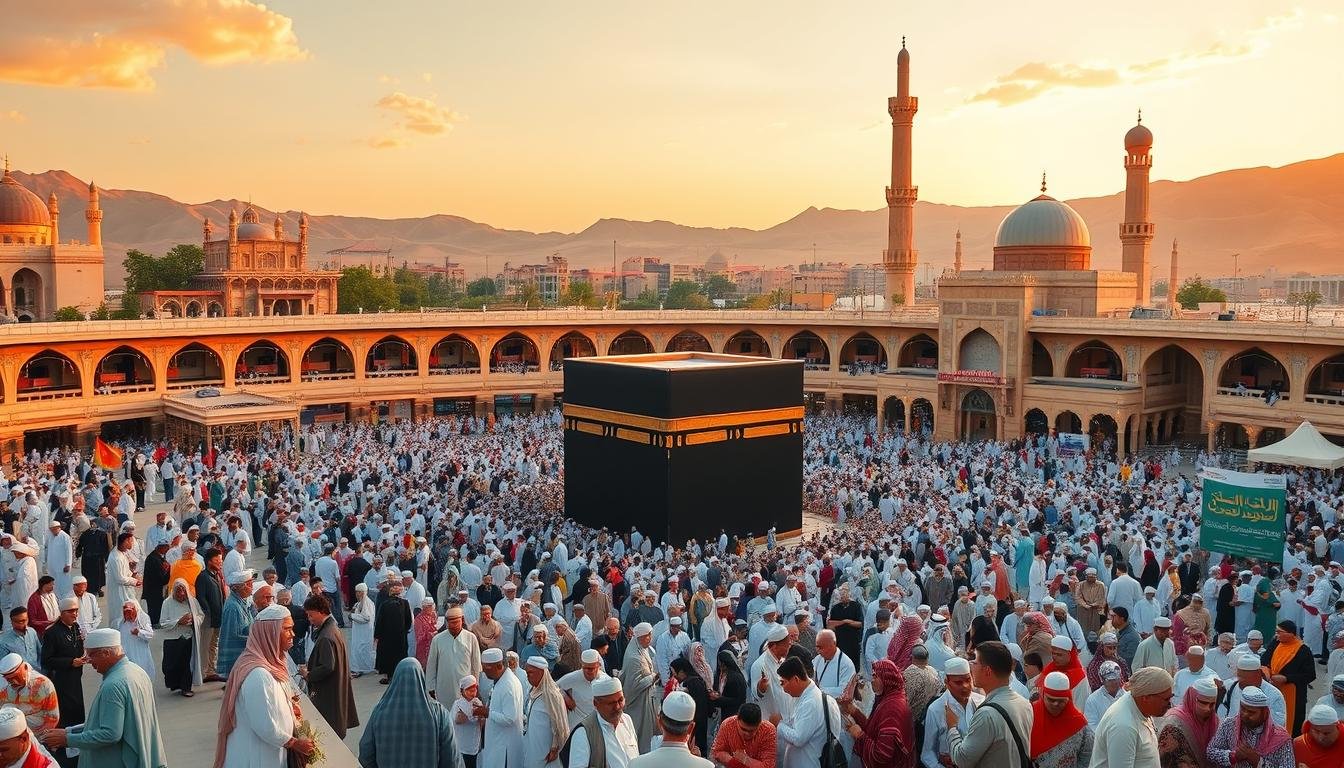Start a spiritual journey in the heart of the Islamic world. Saudi Arabia, where Islam was born, has many historic and holy sites. These places, from Mecca’s sacred areas to Medina’s stunning buildings, are key to the Muslim faith. They offer a deep look into Islam’s rich history.
But what secrets and stories do these places hold? Get ready to be amazed as we reveal the sacred wonders of Saudi Arabia. These sites are a must-see for anyone on a spiritual quest.
As you begin this journey, a question arises: Why are these places so revered? And why should every Muslim add them to their list? Let’s dive into the Islamic heritage and Saudi Arabia’s role in keeping these landmarks alive.
Understanding the Religious and Cultural Significance of Saudi Arabia’s Sacred Sites
Saudi Arabia is a key place in the Islamic world. It is where the Prophet Muhammad was born and Islam’s holiest sites are located. This land has greatly influenced Islamic history, showing the deep religious and cultural importance of every part of the kingdom.
The Role of Saudi Arabia in Islamic History
Saudi Arabia is the guardian of Islam’s most sacred places. It has played a big role in the growth and spread of Islam. The country’s history is closely linked to the start of Islam, marking important events that have shaped the Muslim world.
Religious Tourism in Modern Saudi Arabia
In recent years, Saudi Arabia has seen a big increase in religious tourism. Millions of Muslims visit to perform the Hajj and Umrah pilgrimages. This has helped the economy and made the kingdom the spiritual center of Islam.
Cultural Heritage Preservation Efforts
Saudi Arabia knows how important its sacred sites are. It has worked hard to protect and preserve this heritage. Efforts include restoring old mosques and building top museums, showing the kingdom’s commitment to its legacy.
Saudi Arabia’s role in Islamic history, religious tourism, and cultural preservation is unmatched. Its sacred sites are symbols of faith, attracting millions of visitors. They help keep alive the traditions that have shaped the kingdom for centuries.
Mecca and the Masjid Al-Haram: The Heart of Islam
For Muslims everywhere, Mecca is a place of deep spiritual importance. It is home to the Masjid Al-Haram, or Grand Mosque, the largest and most sacred mosque in the world. This mosque is the key spot for the Hajj pilgrimage, a journey every able-bodied Muslim must make at least once.
The Masjid Al-Haram’s heart is the Kaaba, a simple cuboidal building covered in a black cloth with gold calligraphy. It is seen as the “House of God.” Muslims face the Kaaba during their daily prayers, no matter where they are.
The Masjid Al-Haram and the Kaaba symbolize unity for Muslims. They bridge gaps between different cultures and places. The Hajj pilgrimage shows the strong bond Muslims have with this sacred site.
| Interesting Facts About Mecca and the Masjid Al-Haram |
|---|
| The Masjid Al-Haram covers over 356,000 square meters and can hold over 2 million during the Hajj. The Kaaba was built by Abraham and Ishmael for worship of the one true God. The mosque is constantly being expanded and updated to welcome more pilgrims each year. The Masjid Al-Haram is the only mosque where the prayer direction points directly to the Kaaba. |
Mecca and the Masjid Al-Haram hold a unique place in Islam. As the spiritual center, they attract millions of Muslims. They come to fulfill their duties and strengthen their bond with the divine.
The Prophet’s Mosque in Medina: A Journey Through Islamic Heritage
The Prophet’s Mosque in Medina, also known as the Masjid al-Nabawi, is a key part of Saudi Arabia’s Islamic heritage. It is the final resting place of the Prophet Muhammad. This site is deeply spiritual and plays a big role in his life and legacy.
Architectural Marvels of the Prophet’s Mosque
The Prophet’s Mosque is a stunning example of architecture. It combines traditional Islamic designs with modern touches. The mosque’s domes, calligraphy, and tile work are breathtaking.
The courtyard and arches offer a peaceful place for reflection and prayer. It feels like stepping back in time.
Sacred Areas Within the Complex
- The Rawdah: This area is where the Prophet Muhammad, Abu Bakr, and Umar are believed to be buried.
- The Mihrab: This niche shows the direction of Mecca, where Muslims pray.
- The Minbar: The imam gives sermons from this raised platform.
Best Times to Visit and Prayer Schedules
The Prophet’s Mosque welcomes visitors all year. The best times to go are early morning and late afternoon. This is when it’s less crowded and more peaceful.
Remember to dress modestly and follow the mosque’s rules. This shows respect for the site.
| Prayer Time | Schedule |
|---|---|
| Fajr (Dawn) | 4:30 AM |
| Dhuhr (Noon) | 12:30 PM |
| Asr (Afternoon) | 3:30 PM |
| Maghrib (Sunset) | 6:00 PM |
| Isha (Night) | 7:30 PM |
Historic and Holy Sites in Saudi Arabia Every Traveler Should See
Saudi Arabia is a land filled with history and spiritual importance. It has many must-see holy sites that attract visitors worldwide. The kingdom is a center of Islamic culture and heritage, with historic landmarks of great religious and cultural value. From the sacred heart of Islam in Mecca to the ancient ruins of Madain Saleh, Saudi Arabia’s spiritual landscape is truly awe-inspiring.
The Masjid Al-Haram in Mecca is one of the most iconic sites. It houses the Kaaba, the holiest site in Islam. Pilgrims from all over the globe come here to perform the Hajj and Umrah rituals. This creates a truly transformative experience. The Prophet’s Mosque in Medina is another must-visit, known for its stunning architecture and deep historical significance.
Travelers interested in Saudi Arabia’s history and culture should visit Diriyah. It’s the birthplace of the modern Saudi state. Here, you can marvel at the At-Turaif District, a UNESCO World Heritage site. It showcases traditional Najdi architecture and gives a glimpse into the kingdom’s past.
For those interested in natural wonders, Al-Ula’s sacred valley is a must-see. This breathtaking region has ancient rock art, archaeological discoveries, and a stunning desert landscape. It’s sure to leave a lasting impression on any visitor.
Whether you’re seeking a spiritual journey or a cultural adventure, Saudi Arabia’s historic and holy sites offer a unique and unforgettable experience. From the heart of Islam to the cradle of the Saudi state, these landmarks are a testament to the kingdom’s enduring legacy and its profound impact on the world.
| Must-See Holy Site | Significance |
|---|---|
| Masjid Al-Haram, Mecca | The holiest site in Islam, housing the Kaaba |
| The Prophet’s Mosque, Medina | Renowned for its stunning architecture and historical significance |
| At-Turaif District, Diriyah | A UNESCO World Heritage site showcasing traditional Najdi architecture |
| Al-Ula’s Sacred Valley | Featuring ancient rock art, archaeological discoveries, and stunning natural formations |
The Ancient City of Diriyah: Birthplace of the Saudi State
Diriyah, in the heart of Saudi Arabia, is a treasure trove of history and culture. It’s where the Saudi state was born. The At-Turaif District, a UNESCO World Heritage Site, showcases the area’s architectural and political past.
At-Turaif District UNESCO World Heritage Site
The At-Turaif District in Diriyah is a marvel of traditional Najdi architecture. This mud-brick area, with its towers and alleys, was the first Saudi dynasty’s home. It was also a hub for Islamic learning and governance. Today, visitors can walk through the preserved ruins and learn about its rich history.
Traditional Najdi Architecture
Diriyah’s architecture reflects the region’s cultural heart. The Najdi style, known for its mud-brick buildings and ornate details, is seen everywhere. From the fortresses to the homes, it offers a peek into Saudi Arabia’s architectural heritage.
Historical Museums and Exhibits
Diriyah is also filled with museums and exhibits that explore its history. These places have interactive displays, artifacts, and multimedia that make the city’s story come alive. They help visitors understand Diriyah’s role in shaping the modern Saudi state.
Exploring Madain Saleh: Saudi Arabia’s First UNESCO World Heritage Site
Madain Saleh is a special place in Saudi Arabia’s rich history. It was once a bustling city of the Nabataean civilization. Today, it’s Saudi Arabia’s first UNESCO World Heritage Site.
Madain Saleh, or Al-Hijr, shows off the Nabataeans’ skill in building. They carved tombs and monuments into sandstone cliffs. The site has many well-kept Nabataean rock-cut tombs, each with detailed facades and inscriptions.
Visiting Madain Saleh is like traveling back in time. You can see the Nabataeans’ engineering skills and learn about their culture and beliefs. Highlights include the Qasr al-Bint temple and Jabal Ithlib, where you can find ancient inscriptions and rock art.
Being a UNESCO World Heritage Site shows how important Madain Saleh is worldwide. Saudi Arabia works hard to protect and share this ancient treasure. This ensures the Nabataean legacy continues to inspire and teach visitors from everywhere.
| Key Facts about Madain Saleh | Details |
|---|---|
| Location | Northern region of Saudi Arabia |
| Historical Significance | Former city of the ancient Nabataean civilization |
| UNESCO World Heritage Site | Saudi Arabia’s first UNESCO-designated site |
| Notable Features | Well-preserved Nabataean rock-cut tombs Qasr al-Bint, a magnificent Nabataean temple Jabal Ithlib, with ancient inscriptions and rock art |
| Preservation Efforts | Saudi Arabia’s ongoing initiatives to protect and showcase the site |

Al-Ula’s Sacred Valley: Where History Meets Nature
Al-Ula is in Saudi Arabia’s northwestern region. It’s a place where ancient history meets stunning natural beauty. The sacred valley at its heart is full of cultural and archaeological wonders.
Ancient Rock Art and Inscriptions
The sacred valley of Al-Ula is famous for its rock art and inscriptions. These show the history and beliefs of ancient people. The desert is dotted with petroglyphs and inscriptions, some thousands of years old.
Archaeological Discoveries
The valley is also a key spot for archaeology. Excavations have found amazing artifacts and ruins. These discoveries reveal the area’s complex past, exciting scholars and visitors.
Desert Landscape and Natural Formations
The valley is surrounded by a stunning desert. It has tall rock formations, deep canyons, and wide views. The natural beauty of Al-Ula’s sacred valley is incredible, adding to its cultural heritage.
Visitors can explore ancient rock art, archaeological finds, or the natural beauty. The sacred valley of Al-Ula is a must-see for anyone interested in Saudi Arabia’s history and beauty.
The Historic District of Jeddah: Gateway to Mecca
The historic district of Jeddah, known as Al-Balad, is by the Red Sea coast. It shows Saudi Arabia’s rich culture. This area was once the main path for those going to Mecca.
Al-Balad is famous for its coral buildings and interesting history. The area’s heart has narrow streets and old buildings. These buildings, some over a hundred years old, are made of coral stone.

Al-Balad was key for those going to Mecca. It was a place for traders, pilgrims, and scholars. They brought new ideas and stories, enriching the area.
Now, Al-Balad is a symbol of Saudi Arabia’s culture. People can walk its streets, see the coral buildings, and hear its stories. It’s a gateway to Mecca’s sacred sites.
Sacred Mountain Sites and Religious Landmarks
Saudi Arabia is more than just Mecca and Medina. It has many sacred mountains and religious sites. Places like the Asir Mountains, Rijal Almaa village, and Shubra Palace show the country’s rich heritage. They invite you to experience Saudi Arabia’s spiritual side.
The Asir Mountains in the southwest are a natural wonder. They are home to Rijal Almaa, a UNESCO site known for its old mud-brick buildings and lively culture. Walking through its alleys, you’ll see the locals’ dedication to their traditions.
Shubra Palace, in the north, is a marvel of architecture. Built in the 19th century, it mixes Islamic and European styles. Its halls and tilework are stunning, creating a peaceful atmosphere that has captivated many.
These sites help us understand Saudi Arabia’s spiritual and cultural roots. They are perfect for those seeking spiritual enlightenment or just curious about the country. These places will surely touch your heart and mind.
Conclusion
Saudi Arabia is a place of deep spiritual meaning, attracting visitors from everywhere. It’s home to Mecca and Medina, key sites in Islam. Also, places like Diriyah and Madain Saleh show the country’s rich history.
Visiting these sites is a chance to dive into Saudi Arabia’s history and faith. Walking through these places, you’ll understand the country’s dedication to its heritage. It’s a way to connect with traditions that have lasted for centuries.
Are you looking for a journey that changes you? Saudi Arabia’s holy sites are a great choice. They offer a mix of the sacred and the beautiful. This experience can deeply touch your soul and inspire a lifelong spiritual journey.
FAQ
What are the most significant holy sites in Saudi Arabia that every traveler should see?
Must-see holy sites in Saudi Arabia include Mecca and the Masjid Al-Haram. Also, the Prophet’s Mosque in Medina is a must-visit. Don’t miss the ancient city of Diriyah and the At-Turaif District.
Madain Saleh, the sacred valley of Al-Ula, and the historic district of Jeddah are also key. Sacred mountain sites like the Asir Mountains and Rijal Almaa Village are worth exploring.
What is the significance of Mecca and the Masjid Al-Haram in Islam?
Mecca is the holiest city in Islam. The Masjid Al-Haram, or Grand Mosque, houses the Kaaba. It’s the direction of prayer for Muslims worldwide.
The Masjid Al-Haram is the largest and holiest mosque. It’s the site of the annual Hajj pilgrimage, a duty for Muslims.
What makes the Prophet’s Mosque in Medina such an important Islamic landmark?
The Prophet’s Mosque in Medina is second only to Mecca in holiness. It’s where the Prophet Muhammad is buried. The mosque is famous for its green-domed structure.
It has several sacred areas, attracting Muslim pilgrims and visitors.
What is the historical and cultural significance of the ancient city of Diriyah and the At-Turaif District?
Diriyah is where the Saudi state began. The At-Turaif District, a UNESCO site, shows traditional Najdi architecture. It tells the story of the Al Saud family and the Saudi kingdom’s early days.
Why is Madain Saleh considered an important archaeological site in Saudi Arabia?
Madain Saleh is Saudi Arabia’s first UNESCO World Heritage Site. It was a Nabataean city. The site has rock-cut tombs and inscriptions, offering insights into Nabataean culture.
What makes the sacred valley of Al-Ula a unique destination in Saudi Arabia?
Al-Ula is famous for its ancient rock art and archaeological finds. Its desert landscape is stunning. It’s a treasure trove of Saudi Arabia’s history and culture.
What is the significance of the historic district of Jeddah, known as Al-Balad?
Jeddah’s Al-Balad is known for its coral architecture. It’s a key stop for pilgrims going to Mecca. The area’s heritage buildings and landmarks are a window into Saudi Arabia’s history and Islamic heritage.
What are some of the other sacred mountain sites and religious landmarks worth visiting in Saudi Arabia?
Other sacred sites include the Asir Mountains and Rijal Almaa Village. Shubra Palace is also a must-see. These places showcase Saudi Arabia’s diverse spiritual and cultural heritage.
Don’t forget to share your experience in the comments and follow us on social media at the bottom of the site.

